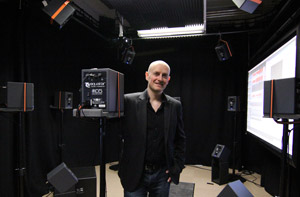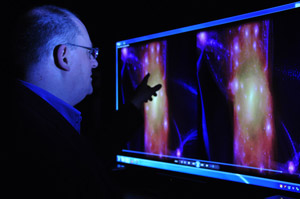New lab boosts groundbreaking interactive media research
We are surrounded by an explosion in interactive media, with this rapidly evolving industry touching on more and more aspects of our daily lives.
At the University of York, a new Interactive Media Laboratory is helping two researchers to stay at the forefront of the quest to develop and improve our audio and visual experiences.
Dr Gavin Kearney specialises in 3D audio systems, while his Department of Theatre, Film and Television colleague, Professor Nick Holliman, is an expert in 3D visual systems.
3D audio systems
Dr Gavin Kearney is on a mission: to give television viewers the same immersive experience they would have in a cinema, but without the need for loudspeakers in every corner of their living room.

Dr Gavin Kearney in the new Interactive Media Lab (credit: Lisa Burch)
“There is a trend in the cinema industry to significantly increase the number of loudspeakers in theatres for enhanced spatial audio experience,” says Dr Kearney. “Conversely, in the home, technology is shrinking, and consumers are investing in soundbar technologies, which tend to have significant compromises in terms of sound quality and spatial performance. We’re looking to give viewers in the home the same sonic experience they would have in the cinema, but using a limited number of speakers in the living room, preferably at the TV.”
His research has been given a boost with the opening of a new purpose-built Interactive Media Laboratory on Heslington East, equipped with a 16-channel loudspeaker system, 3D visual and virtual reality systems, and head-mounted display equipment.
The new lab is allowing him to carry out perceptual listening tests, as well as to experiment with, and develop, the very latest technology.
“The challenge we face is that everyone’s ears, like their fingerprints, are unique, and so what might be rendered as good spatial sound for one person may not work well for another, says Dr Kearney. “We need to find a practical process which will allow everybody to experience enhanced immersive sound in the home.
“We’re working towards creating robust ‘virtual headphones’ through acoustic research and perceptual listening evaluation. We need to develop signal processing that models how real-world sources – and loudspeaker systems – impart their soundfields onto a listener’s ears.”
Through his work, Dr Kearney has already developed efficient processing techniques that provide people with the impression that they are listening to a large loudspeaker array using headphones. Now the challenge is to do the same for soundbar technology.
Applications for this research are not limited to TVs, but extend to gaming, teleconferencing, training simulators, e-learning, cognitive therapy – anywhere where immersive sound fields are needed.
3D visual systems
Professor Nick Holliman is a recent addition to York’s staff, bringing with him 20 years of experience in 3DTV research.

Professor Nick Holliman inspecting the 3D film Cosmic Origins 2 before sending it to the stereoscopic displays and applications 3D film competition (3 February, San Francisco, California). Cross-modal research in how 3D vision and sound combine aims to improve the perceived depth quality in films like this. (credit: Lisa Burch)
His research addresses the science and engineering of interactive digital media, with a specialty in binocular 3D, including the theory, human factors, and applications of 3D displays. For example, he investigates questions such as how people perceive 3DTV, and how to produce better pictures fitted to how people see.
While his work has obvious implications for the gaming industry, digital media and cinema, it also has more unusual applications such as the use of 3D screens for improving baggage inspection at airports.
Professor Holliman says, “Not everyone finds viewing 3D images comfortable and the challenge is to find ways of improving the experience. Combining audio-visual enhancement may provide the answer.”
In a recent news article for SPIE, ('Using auditory depth cues to enhance stereoscopic visual media'), he argues that auditory cues influence depth perception in 3DTV and could potentially extend the range of depth for comfortably viewing a 3D game or film. He has been invited to present more on this work at the Electronic Imaging Symposium in San Francisco on 4 February.
The audio and visual systems he and Dr Kearney have brought together in the new Interactive Media Lab will allow Professor Holliman to progress this area of research. He says, “One of the attractions of York for me was the range of potential new collaborators. In building the new Laboratory we will support our own research and develop exciting new strands of audio-visual based research with leading colleagues across the University.”
Professor Holliman will be jointly leading a new BSc in Interactive Media with Professor Marian Ursu. The new multidisciplinary undergraduate degree programme, which welcomes its first cohort of students in September, will combine theory and practice, bringing together technical, creative and socio-cultural perspectives on new media systems, interactive technologies and digital culture. Third-year students on the new course, as well as postgraduate students, will be able to benefit from the new research Interactive Media Laboratory.
Futher information
- The Interactive Media Laboratory is based in the superb £30m Department of Theatre, Film and Television building on Heslington East. For more information on the Department visit www.york.ac.uk/tftv
- More information on the BSc in Interactive Media at www.york.ac.uk/tftv/undergraduate/bsc-in-interactive-media/
